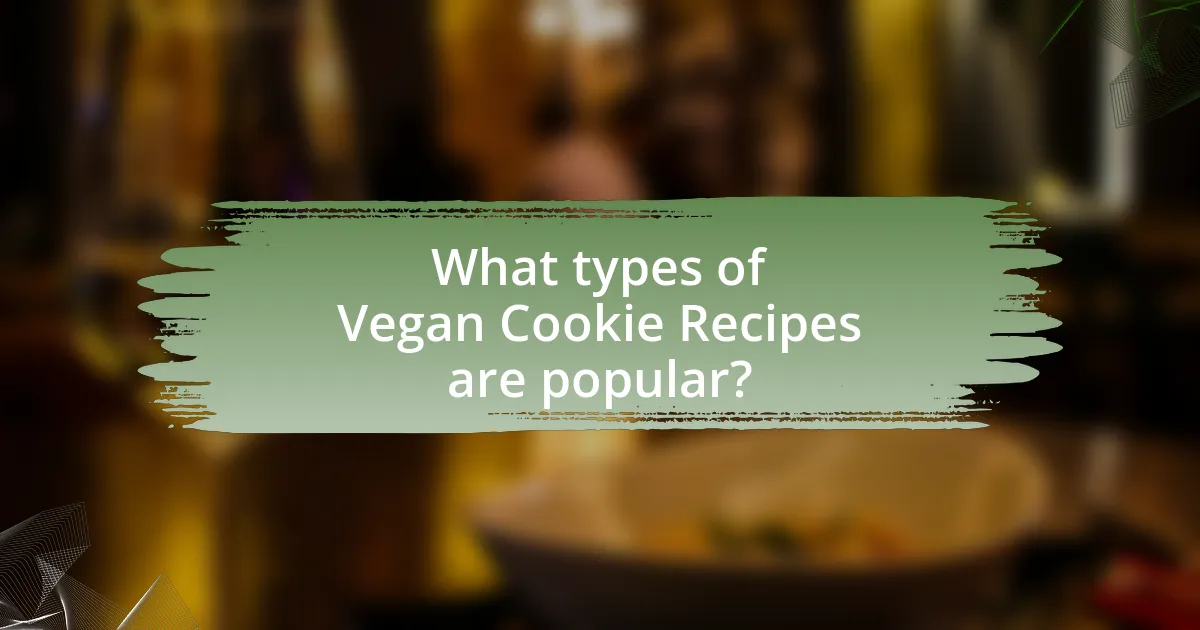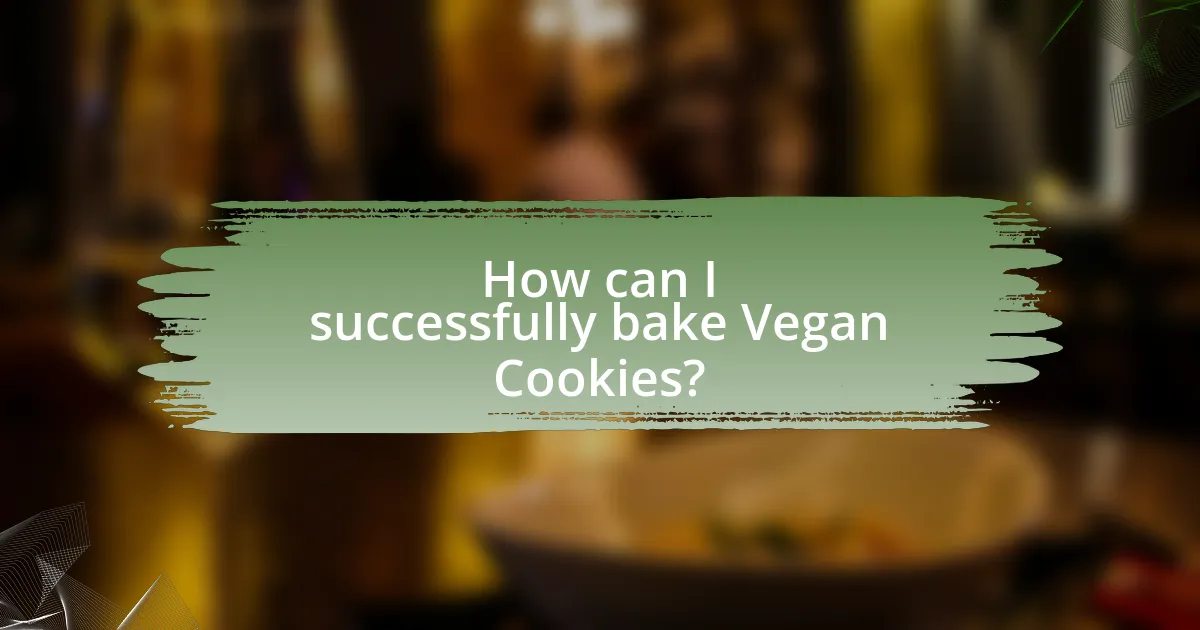Vegan cookie recipes are formulations that exclude animal-derived ingredients, utilizing plant-based substitutes to achieve desirable textures and flavors. This article explores the differences between vegan and traditional cookie recipes, highlighting common ingredients and the importance of dairy substitutions for dietary inclusivity. It discusses the health benefits of vegan cookies, their environmental advantages, and ethical considerations, while also providing popular recipe examples and tips for successful baking. Additionally, it offers insights into storing and serving vegan cookies, ensuring they remain fresh and appealing for various occasions.

What are Vegan Cookie Recipes?
Vegan cookie recipes are formulations for cookies that do not include any animal-derived ingredients, such as eggs or dairy. These recipes typically utilize plant-based substitutes like applesauce, flaxseed meal, or nut butters to achieve the desired texture and flavor. For example, a common vegan cookie recipe might use almond flour and coconut oil instead of traditional flour and butter, ensuring that the final product remains both delicious and suitable for a vegan diet.
How do Vegan Cookie Recipes differ from traditional cookie recipes?
Vegan cookie recipes differ from traditional cookie recipes primarily by omitting animal-derived ingredients such as eggs and dairy. Instead, vegan recipes utilize plant-based substitutes like flaxseed meal or applesauce for binding and coconut oil or nut butters for moisture. This substitution not only caters to dietary restrictions but also aligns with ethical and environmental considerations associated with veganism. For example, a study published in the Journal of Agricultural and Food Chemistry highlights that plant-based ingredients can provide similar textures and flavors to traditional cookies while reducing the carbon footprint associated with dairy and egg production.
What ingredients are commonly used in Vegan Cookie Recipes?
Common ingredients in vegan cookie recipes include flour, sugar, plant-based butter or oil, non-dairy milk, and baking powder. These ingredients replace traditional dairy and egg components, allowing for a plant-based alternative. For instance, all-purpose flour serves as the primary structure, while plant-based butter or oil provides moisture and richness. Non-dairy milk, such as almond or soy milk, acts as a liquid binder, and baking powder helps the cookies rise. This combination ensures that vegan cookies maintain a desirable texture and flavor, similar to their non-vegan counterparts.
Why is it important to substitute dairy in cookie recipes?
Substituting dairy in cookie recipes is important to accommodate dietary restrictions and preferences, such as lactose intolerance or veganism. Many individuals cannot consume dairy due to allergies or ethical beliefs regarding animal products, making dairy-free alternatives essential for inclusivity in baking. Research indicates that approximately 65% of the global population has a reduced ability to digest lactose after infancy, highlighting the necessity for dairy substitutes in recipes to ensure that a wider audience can enjoy baked goods without adverse effects.
What are the benefits of making Vegan Cookies?
Making vegan cookies offers several benefits, including health advantages, environmental sustainability, and ethical considerations. Health-wise, vegan cookies typically contain less saturated fat and cholesterol compared to traditional cookies, as they exclude animal products. This can lead to improved heart health and lower risks of chronic diseases. Environmentally, plant-based ingredients require fewer resources and produce lower greenhouse gas emissions than animal-derived ingredients, contributing to a more sustainable food system. Ethically, making vegan cookies aligns with animal welfare principles, as it avoids the use of animal products and supports cruelty-free practices. These benefits collectively make vegan cookies a healthier, more sustainable, and ethically responsible choice.
How do Vegan Cookies contribute to a healthier diet?
Vegan cookies contribute to a healthier diet by eliminating animal products and often incorporating whole, plant-based ingredients. These cookies typically contain healthier fats, such as those from nuts or avocados, instead of saturated fats found in butter. Additionally, vegan cookies often use natural sweeteners like maple syrup or agave nectar, which can have a lower glycemic index compared to refined sugars. Research indicates that diets high in plant-based foods are associated with lower risks of chronic diseases, including heart disease and diabetes, due to their higher fiber content and lower levels of cholesterol. Therefore, choosing vegan cookies can support overall health while satisfying sweet cravings.
What environmental benefits come from choosing Vegan Cookies?
Choosing vegan cookies significantly reduces environmental impact by lowering greenhouse gas emissions, conserving water, and minimizing land use. Animal agriculture is responsible for approximately 14.5% of global greenhouse gas emissions, primarily due to methane from livestock. In contrast, plant-based ingredients used in vegan cookies require less water; for instance, producing one pound of almonds requires about 1,900 gallons of water, while dairy production demands significantly more. Additionally, vegan cookies contribute to reduced land use, as raising animals for food requires extensive grazing and feed crop areas. By opting for vegan cookies, consumers support a more sustainable food system that mitigates climate change and conserves natural resources.

What types of Vegan Cookie Recipes are popular?
Popular types of vegan cookie recipes include chocolate chip cookies, oatmeal cookies, peanut butter cookies, and snickerdoodles. Chocolate chip cookies are a favorite due to their classic flavor and the ability to use dairy-free chocolate chips. Oatmeal cookies are popular for their chewy texture and the option to add fruits or nuts. Peanut butter cookies are favored for their rich taste and simplicity, often requiring just a few ingredients. Snickerdoodles are enjoyed for their cinnamon-sugar coating and soft texture. These recipes are widely shared and adapted in vegan cooking communities, reflecting their popularity and versatility.
How can I make classic Vegan Chocolate Chip Cookies?
To make classic Vegan Chocolate Chip Cookies, combine 1 cup of almond butter, 1/2 cup of maple syrup, and 1 teaspoon of vanilla extract in a bowl. Then, mix in 1 cup of flour, 1/2 teaspoon of baking soda, and a pinch of salt until a dough forms. Finally, fold in 1 cup of dairy-free chocolate chips. Bake at 350°F (175°C) for 10-12 minutes. This recipe is validated by its popularity in vegan baking communities, showcasing a simple method to create delicious cookies without animal products.
What are the key ingredients for Vegan Chocolate Chip Cookies?
The key ingredients for Vegan Chocolate Chip Cookies include flour, sugar, plant-based butter or coconut oil, non-dairy milk, baking soda, vanilla extract, and dairy-free chocolate chips. These ingredients replace traditional cookie components while maintaining texture and flavor. For instance, plant-based butter or coconut oil serves as a substitute for dairy butter, ensuring the cookies remain vegan-friendly. Non-dairy milk, such as almond or soy milk, provides moisture without animal products, while baking soda acts as a leavening agent to help the cookies rise.
What tips can enhance the flavor of Vegan Chocolate Chip Cookies?
To enhance the flavor of Vegan Chocolate Chip Cookies, incorporate ingredients like brown sugar, which adds moisture and a deeper caramel flavor compared to white sugar. Additionally, using high-quality dark chocolate chips can significantly elevate the taste, as they provide a richer chocolate experience. Adding a pinch of sea salt enhances the sweetness and balances the flavors, while incorporating vanilla extract deepens the overall flavor profile. Finally, consider adding spices such as cinnamon or nutmeg for warmth and complexity, which can transform the cookie’s taste.
What unique Vegan Cookie Recipes can I try?
Unique vegan cookie recipes to try include chickpea chocolate chip cookies, avocado oatmeal cookies, and sweet potato peanut butter cookies. Chickpea chocolate chip cookies utilize blended chickpeas for a protein-rich base, while avocado oatmeal cookies incorporate ripe avocados for healthy fats and moisture. Sweet potato peanut butter cookies combine mashed sweet potatoes with peanut butter for a naturally sweet and nutritious treat. These recipes not only provide unique flavors but also offer health benefits, making them excellent alternatives to traditional cookies.
How do I make Vegan Peanut Butter Cookies?
To make Vegan Peanut Butter Cookies, combine one cup of natural peanut butter, one cup of brown sugar, and one teaspoon of vanilla extract in a mixing bowl. Mix until smooth, then add one teaspoon of baking soda and a pinch of salt, stirring until fully incorporated. Form the dough into balls and place them on a baking sheet lined with parchment paper, flattening each ball slightly. Bake at 350°F (175°C) for about 10-12 minutes until the edges are golden. This recipe is valid as it utilizes common vegan ingredients and follows standard baking practices for cookies.
What variations can I add to Vegan Oatmeal Cookies?
You can add various ingredients to Vegan Oatmeal Cookies to enhance their flavor and texture. Common variations include incorporating nuts such as walnuts or pecans for crunch, adding dried fruits like cranberries or raisins for sweetness, and mixing in chocolate chips or cacao nibs for a rich taste. Additionally, spices such as cinnamon or nutmeg can elevate the flavor profile, while using different types of nut butters, like almond or cashew, can provide a unique twist. These variations not only diversify the cookie experience but also allow for customization based on personal preferences and dietary needs.

How can I successfully bake Vegan Cookies?
To successfully bake vegan cookies, use plant-based ingredients such as flour, sugar, baking soda, and a fat substitute like coconut oil or applesauce. These ingredients replace traditional dairy and eggs, allowing for a similar texture and flavor. For example, using flaxseed meal mixed with water can act as an egg substitute, providing binding properties essential for cookie structure. Research indicates that vegan cookies can achieve desirable textures and flavors comparable to non-vegan versions when the right ratios and ingredients are used, such as a 1:3 ratio of flaxseed meal to water for binding.
What common mistakes should I avoid when baking Vegan Cookies?
When baking vegan cookies, common mistakes to avoid include using the wrong type of flour, not measuring ingredients accurately, and neglecting to account for the moisture content of vegan substitutes. Using all-purpose flour instead of whole wheat or gluten-free options can affect texture, while inaccurate measurements can lead to poor consistency. Additionally, vegan ingredients like applesauce or nut butters can add moisture, so adjusting the liquid content in the recipe is crucial for achieving the desired cookie texture.
How can I ensure the right texture in my Vegan Cookies?
To ensure the right texture in your vegan cookies, use a combination of the right flour, fat, and moisture. For instance, using a blend of all-purpose flour and whole wheat flour can provide structure while adding a bit of chewiness. Incorporating fats like coconut oil or vegan butter helps achieve a rich texture, while adding ingredients such as applesauce or nut butter can enhance moisture without compromising the cookie’s integrity. Research indicates that the balance of these components directly influences the final texture, as the ratios of fat to flour and the type of liquid used can significantly alter the outcome.
What baking techniques are essential for Vegan Cookies?
Essential baking techniques for vegan cookies include using appropriate egg substitutes, properly creaming fats and sugars, and adjusting baking times and temperatures. Egg substitutes like flaxseed meal or applesauce provide binding and moisture, crucial for texture. Properly creaming vegan butter or coconut oil with sugars ensures a light and airy cookie structure. Additionally, vegan cookies often require slight adjustments in baking times and temperatures due to the absence of dairy, which can affect how cookies spread and set. These techniques are validated by numerous vegan baking resources that emphasize the importance of these methods for achieving optimal results.
What are some tips for storing and enjoying Vegan Cookies?
To store and enjoy vegan cookies effectively, keep them in an airtight container at room temperature to maintain freshness for up to a week. For longer storage, freeze the cookies in a single layer on a baking sheet, then transfer them to a freezer-safe bag, which can preserve their quality for up to three months. When ready to enjoy, thaw the cookies at room temperature or warm them briefly in the oven to restore their texture. These methods ensure that the cookies remain soft and flavorful, enhancing the overall eating experience.
How can I keep my Vegan Cookies fresh for longer?
To keep vegan cookies fresh for longer, store them in an airtight container at room temperature. This method prevents moisture loss and protects the cookies from exposure to air, which can lead to staleness. Additionally, placing a slice of bread in the container can help maintain moisture levels, as the bread will absorb excess humidity. Research indicates that cookies stored in airtight conditions can remain fresh for up to a week, while refrigeration can extend their shelf life even further, though it may alter the texture.
What are the best ways to serve Vegan Cookies at gatherings?
The best ways to serve vegan cookies at gatherings include presenting them on decorative platters, offering a variety of flavors, and providing clear labeling for dietary preferences. Decorative platters enhance visual appeal, making the cookies more inviting. A variety of flavors, such as chocolate chip, oatmeal raisin, and peanut butter, caters to diverse tastes and encourages guests to try multiple options. Clear labeling helps guests identify vegan options, ensuring those with dietary restrictions feel included. These methods not only enhance the overall experience but also promote the enjoyment of vegan treats among all attendees.




